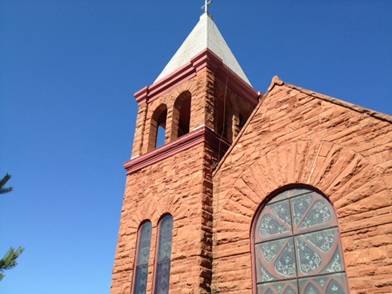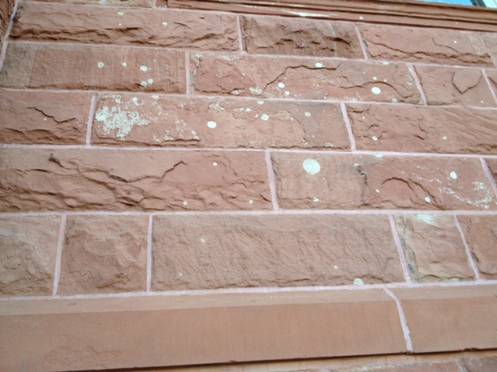
JACOBSVILLE SANDSTONE CHURCHES
Cache Summary:
Jacobsville sandstone is a red sandstone found in the Upper Peninsula and portions of Ontario. There were 32 quarries in the Upper Peninsula which operated between 1870 and 1915. It was named Jacobsville sandstone after the town notable for its production, Jacobsville, Michigan. The Jacobsville sandstones contains mysterious white spots in the red sandstone. Scientist have proposed two theories to the causes of the white color which will be explored in this EarthCache.

Figure 1.St. Ignatius Loyola Church in Houghton, Michigan. Photo by C. Myers.
Cache coordinates: 47 o 7.220 N 88 o 33.908 W
What caused the red and white coloring in the Jacobsville Sandstone?
Red Sandstones:
Scientists agree that the Jacobsville sandstone is red due to the iron oxides present in the sandstone which were oxidized by water flowing through the pores in the rock. These sandstones form from older rocks (granite and gneiss) which get weathered and break down into sand-sized sediments. The quartz and feldspar grains from the granite and gneiss were transported and deposited by water into the rift valley. The sand grains that eroded from those older rocks contained iron which wasn’t oxidized. After the sands were deposited, ground water containing dissolved oxygen moved through pore spaces between the grains of sand. The oxygen in the water removes electrons from ferrous iron to produce rust-like ferric iron oxides, turning the sand grains rusty red. Ferric iron oxides are formed by the combination of iron and oxygen. The type of iron oxide in the Jacobsville sandstone is known as hematite (FeO3). Hematite is a Greek word for “blood.”

Figure 2.White “spots” in the sandstone blocks of St. Ignatius Loyola Church in Houghton, Michigan taken by C. Myers.
White Spots:
Although this sandstone is mostly rusty red it has white spots and streaks that are abundant throughout most of the sandstone. It is also mottled with various pinks and browns. There are many white streaks and dots found throughout the building stones of the church. Scientists have proposed two main explanations for the presences of the abundant white spots.
An older hypothesis proposes that white spots develop by leaching and bleaching of the rock after it had developed its red color, where red ferrous iron is leached away over time. Sandstone is very porous like water through a sponge. Under certain conditions when water infiltrates the sandstone, reducing agents in water add electrons to iron and iron is reduced while oxygen is removed. The ferrous iron is soluble in water. The reduced ferrous iron could then dissolve in the groundwater and be removed making the sandstone colorless or white. Some waters contain reducing agents such as: hydrocarbons (petroleum), weak acids (similar to vinegar), Hydrogen sulfide (gas that smells like rotten eggs).
A newer and more likely hypothesis proposes that the white spots were never oxidized initially and therefore were never red. This idea comes from the theory that organic material was in these spots from very primitive life forms and formed a chemical shield around themselves to prevent oxidation. As they broke down the spots were replaced by clay and calcium carbonate which filled the pores in the sandstone. Hematite and ferric iron are not present in the cements and clay materials which have formed in the pores of the sandstone. Instead the iron present here is reduced and may dissolve and be carried away by the ground water. This is an example of a redox chemical reaction which occurs in rock pores. The key concept here is that the sandstone was white first, and because tiny iron rich grains got oxidized by oxygen rich water passing through the pores between sand grains, it turned rusty red. Where there was reduced carbon, possibly remaining from organic material, a reduced shield prevented the oxidation, leaving a white pot or white streak. The result is a beautiful rock.
For more information
Visit the nearby Jacobsville Sandstone Buildings EarthCache to explore the characteristics of this rock and why it was commonly used as a building stone. This is a MiTEP earthcache (Michigan Teachers Educational Program) For more information on the St Ignatius Loyola Church visit their webpage at http://www.dioceseofmarquette.org/parish.asp?parishID=140.
Logging your visit:
Observe the building stones that make up the church. Which hypothesis do you think provides the best explanation for the white spots? Give me evidence and the reasoning behind your claim.
____________________________________________________________________________________________________________________________________________________________________________________________________________________________________________________
Earth Science Literary Principles Big Ideas:
Big Idea #1
“Earth Scientists use repeatable observations and testable ideas to understand and
explain our planet. “
These white “spots” can be seen on numerous red sandstone buildings. Anyone can observe them on a number of sandstone buildings in Houghton, Michigan.
Common Earth Science Misconceptions:
A common misconception about red sandstone is “Scientific ideas are absolute and unchanging.”
The red sandstone does change color after its deposition and is influenced by how much oxygen exists in the rock pores. If the sandstone is shielded by a reducing agent it remains white. If not it gets rusty red. The sandstone forms from grains broken from an older rock like granite or gneiss which is igneous or metamorphic rock. This is a good example of the rock cycle.
____________________________________________________________________________________________________________________________________________________________________________________________________________________________________________________
References:
Chan, Marjorie A., & Parry, William T. From Rainbow of Rocks, Mysteries of Sandstone Colors and Concretions in Colorado Plateau Canyon Country. Public Information Series 77 Utah Geologic Survey a division of the Department of natural Resources. Retrieved from: http://geoogy.utah.gov/online/pdf/pi-77.pdf. Reviewed: July 2012
Jacobsville Sanstone. From Wikipedia, the free encyclopedia. Retrieved from: http://en.wikipedia.org/wiki/jacobsville_Sandstone Reviewed: July 2012
Rose, Bill, Jacobsville Sandstone Retrieved from: www.geo.mtu.etu/~raman/joacobsville.mp4 Reviewed: July 2012
St Ignatius Loyola Church from Michigan State Historic Preservation Objects. Retrieved from: http://www.mcgi.state.mi.us/hso/sites/5903.htm Reviewed: July 2012